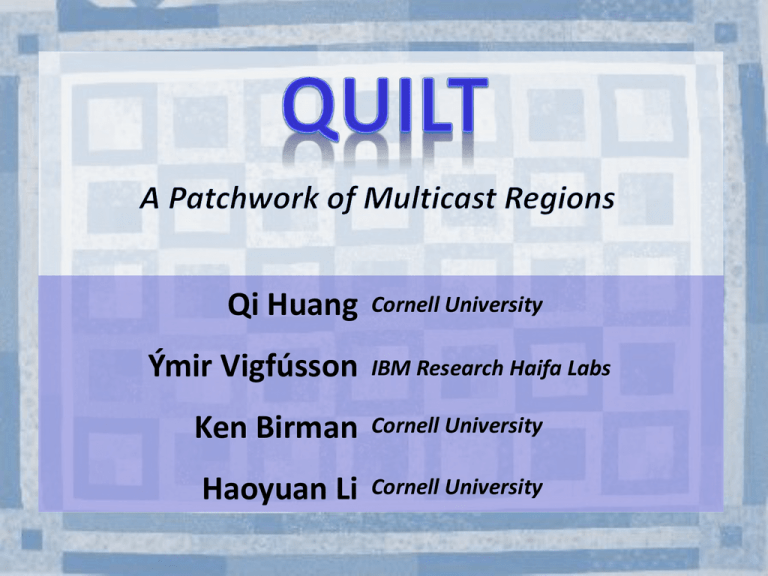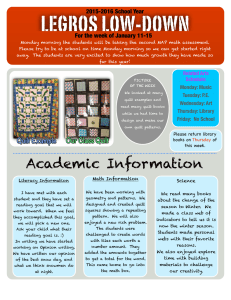Qi Huang Ýmir Vigfússon Ken Birman Haoyuan Li
advertisement

Qi Huang Ýmir Vigfússon Cornell University IBM Research Haifa Labs Ken Birman Cornell University Haoyuan Li Cornell University Pub/sub transport Pub/sub over WAN has plethora of modern uses Facebook and Twitter real-time feeds Web and cloud management Massive multiplayer online games (MMOGs) Component of numerous DEBS applications What about multicast over WAN? Multicast: One-to-many message dissemination A natural transport mechanism for pub/sub Wishlist: i. ii. iii. iv. v. Minimize redundant traffic Minimize average latency of delivery yet with high throughput Limit per-node storage requirements Stay robust to node churn/failures Automatically adapt to the runtime environment Status of Multicast IP-multicast (IPMC) Disabled over WAN links Security concerns (DDoS attacks) Economic issues (how do you charge for IPMC?) Enabled in many data centers Possible to fix scalability and reliability issues Application-level multicast (ALM) Iterated unicast does not scale Use an overlay Dissemination overlays ignore underlying topology and IPMC Peer-to-peer structures usually vulnerable to churn Mesh solutions have high overhead and increase latency No known solution achieves all of our goals Can one size fit all? Introducing Quilt Idea: What if we combine multiple multicast solutions? Quilt weaves multicast regions into a patchwork: Discovers context automatically Optimizes efficiency Exports a simple library interface for developers Routes messages between regions Allows administrators to impose policy (e.g. enable IPMC) Motivation Quilt Overview Environment Identifier (EUID) Quilt Architecture Bootstrap server Churn resilience Evaluation Data Center Topology Internet Topology Conclusion Duplication suppression Quilt Overview Quilt exposes a simple multicast API to end-user applications The multicast container stores active protocol “objects” Multicast Protocols Quilt prototype supports three multicast protocols IPMC Network-level IP multicast DONet (CoolStreaming) Mesh-structured multicast BitTorrent-style content dissemination OMNI Tree-based latency-aware multicast Optimizes average latency from source without burdening internal nodes Quilt uses OMNI for global patch multicast Quilt Overview Quilt exposes a simple multicast API to end-user applications The multicast container stores active protocol “objects” The detection service discovers environment properties NATchecker, traceroute, latency + bandwidth statistics Constructs environment identifier (EUID) Environment Identifier For each NIC, what transport protocols are supported and in which direction? 74% of hosts run behind NAT boxes and firewalls These hosts might be limited to a leaf-role Environment Identifier Trace the routing path to the local DNS server If two hosts share a DNS server or an intermediate router within 5 hops, then belong to the same AS with 85% probability Check for IPMC capabilities as well Environment Identifier Periodically estimate network performance Fluctuates over time, so measurements encoded as ranges of values Patch formation Bootstrap sequence New host generates EUID for each NIC Sends EUID to bootstrap server Receives EUIDs for initial contacts in compatible regions Rules Patches defined by EUIDs based on ALM rules E.g. if IPMC enabled router is shared between E1 and E2, a region is formed with EUID E1,2 Members eventually get a single maximal EUID Global patch A wide-area overlay connects other regions Overlaps in some representative node for each patch Bootstrap server Three main roles i. Maintain partial membership for each patch ii. Structure nodes into patches iii. Ensure health of global patch Off the critical path Only used on joins and when nodes become isolated Gossip version of Quilt Distributed maintenance of membership. Alleviates single-point-of-failure concerns Churn resilience Each patch has a representative node Tunnels traffic between the patch and the global patch What about churn? The quilt overlay may partition if the representative leaves For robustness, Quilt has k representatives in each patch Here k is a small number, like 2 or 3 Increasing k in turn increases message duplication Quilt is able to recover after failure Hosts periodically report to the bootstrap server, ensuring fresh membership snapshot Representatives are monitored and new ones appointed if they die Duplication suppression More representatives more duplicates Suppressing duplicates per host Each host maintains a Bloom filter, and marks incoming messages Reset filter periodically depending on multicast data rate Suppressing duplicates among representatives Gossip-based protocol links patch representatives within multicast region Since k is tiny, use simple 2-phase synchronization protocol Motivation Quilt Overview Environment Identifier (EUID) Quilt Architecture Bootstrap server Churn resilience Evaluation Data Center Topology Internet Topology Conclusion Duplication suppression Data Center Topology Application: Publish/subscribe event notification among data centers linked on Internet WAN. Grid5000 structure links 25 clusters (1531 servers) from 9 locations in France Sub-millisecond latencies within clusters, 4-6ms between sites Assumptions: Single-source multicast IPMC is enabled within each site, but not between them Data Center Topology Overhead: Quilt has substantially less network overhead than pure OMNI for constructing the overlay. The Quilt overlay trees are much smaller. Data Center Topology Latency: Quilt leverages IPMC to accelerate event dissemination unlike the system-wide OMNI tree. Data Center Topology 50% of nodes die # of Patch Representatives Churn resilience: Quilt recovers quickly even from catastrophic failures (50% of nodes randomly die), or within 10 seconds. Data Center Topology 50% of nodes die Duplication suppression: Bloom-filters and 2-phase synchronization among representatives are effective. Internet Topology Application: Internet-wide dissemination A synthetic collection of 951 Internet hosts End-to-end latency between hosts from PeerWise Selected random hosts from CAIDA traceroute records with similar host-to-host latencies and gathered route information Assumptions: Single-source multicast IPMC is not enabled Quilt uses DONet within patches and OMNI between them Internet Topology Latency: Quilt disseminates data quicker than DONet by avoiding expensive BitTorrent-style scheduling cycles. Internet Topology Overhead: Quilt avoids the BitTorrent-style overheads experienced by DONet. Internet Topology 50% of nodes die Churn resilience: Many small regions makes recovery harder, but still relatively quick. Duplication suppression: 50% fewer duplicates when k=2, 63% lower when k=3. • Impractical to create a one-size-fits-all multicast solution • Many internet nodes separated by WAN links • Small clusters of nodes residing behind NAT or firewall • Larger clusters in settings where IPMC is available • Quilt weaves a patchwork of multicast regions • Automatic environment detection and region formation • Resilient to churn and suppresses duplicates • Lightweight and scalable multicast service • Quilt actually works! • Free download at Cornell’s Live Distributed Objects site: •http://liveobjects.cs.cornell.edu



